The only way for a Index RSI trade to result in a profit is if the buy and sell orders are executed at exactly the right time. Traders usually make the mistake of selling their assets too quickly, resulting in a loss of capital, or they persist in trading despite the fact that the market has turned against them. As a consequence of this, the amount of money gained from the transaction typically drops below the breakeven point. While it is essential to move in the same direction as the market, it is also essential to keep an eye out for signs that the market may be about to turn. Traders who learn to recognize these red indicators have a better chance of avoiding the common scenario of buying at high prices and selling at lower prices, which occurs frequently among novice traders. One indicator that can be helpful to traders in identifying reversals in a trend is the relative strength index (RSI).
The Basics Of RSI
The relative strength index, also known as the RSI, is a momentum indicator that can vary from 0 to 100 and can anticipate the next change in value. The most typical application for this indicator is to determine if an instrument is overbought or oversold. When the inherent value of an asset is exceeded, either in the short term or in the long term, the asset is considered to have been overbought, and this is the first indication that the asset’s price may need to be adjusted downward. On the other hand, an oversold zone indicates that the item in question has been sold beyond its capacity and is currently being exchanged at a price that is lower than its intrinsic value. It has been decided that these assets are ready to undergo restoration.
[rb_related title=”More Read” style=”light” total=”4″]
It is in the bulls’ best advantage for the RSI to be between 50 and 100 when the market is being traded. It signifies that the bears are in control if it is between 0 and 50 on either hand. When the Relative Strength Index (RSI) reaches 50, this level is regarded as neutral and indicates that bulls and bears are in an equal amount of control over the market. A trade can only make money if the buy and sell orders are carried out at exactly the right time. Most traders make the mistake of selling their assets too quickly, which causes them to lose money, or they keep trading even when the market is going against them. Because of this, the amount of money made from the deal usually falls below the point where it breaks even. ALSO READ GMT Investments Review: Trading Tools You Need to Make Profit Easier. Bay Exchange Expert Review – Is it a Scam or a Legit? LocalTrade Expert Review – Is LocalTrade Scam or Legit? It’s important to move in the same direction as the market, but it’s also important to watch for signs that the market may be about to change. If a trader learns to recognize these red signs, he or she has a better chance of not buying at high prices and selling at low prices, which is a common mistake made by new traders. The relative strength index is a type of indicator that can help traders spot changes in a trend (RSI). How to Understand RSI The relative strength index, or RSI, is an indicator of momentum that can range from 0 to 100 and can predict the next change in value. Most of the time, this indicator is used to figure out if an instrument has been overbought or oversold. When the short-term or long-term value of an asset is higher than its intrinsic value, the asset is said to have been overbought. This is the first sign that the price of the asset may need to go down. On the other hand, an oversold zone means that the item has been sold more than it can hold and is now being traded at a price that is less than what it’s worth. The decision has been made that these assets are ready to be fixed up. When the market is being traded, the RSI should be between 50 and 100. This is best for the bulls. If it is between 0 and 50 on either hand, it means that the bears are in charge. When the Relative Strength Index (RSI) reaches 50, this is considered neutral and shows that bulls and bears have about the same amount of control over the market. 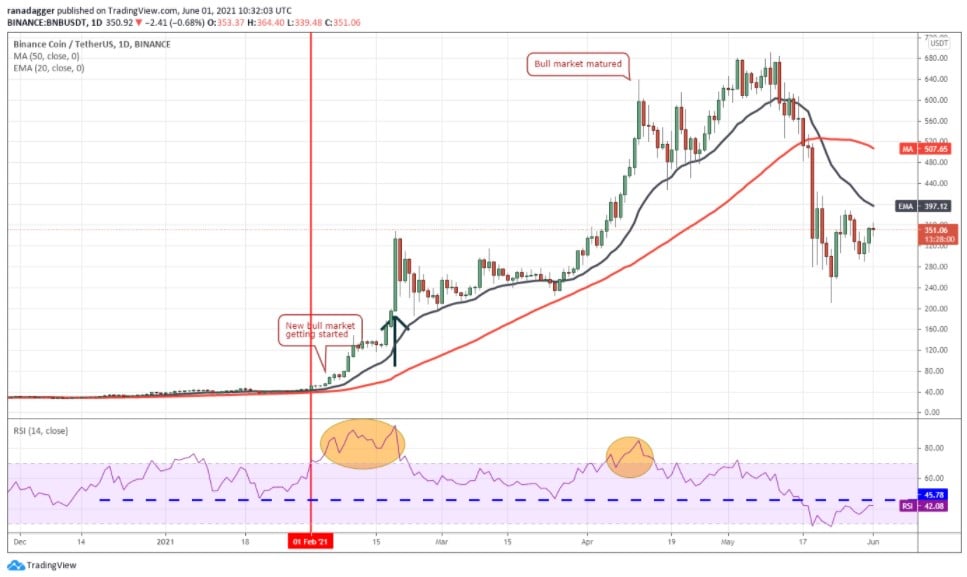 As can be seen in the graph located above, the all-time high for Binance Coin (BNB) was surpassed in February of last year, and the beginning of the subsequent phase of its upward trend began at that time. Since the RSI is now higher than 70, this suggests that Altcoin has been overbought. Traders who sell their assets at this time will miss out on a sizeable portion of the earnings that will be made in the future. Take note that the RSI is likely to continue to be in an overbought zone even if a coin begins a new uptrend by breaking through a zone or significant limitation levels. This is due to the fact that experienced traders are able to recognize the beginning of a fresh upswing and start buying right away rather of waiting for the market to decline. Because continual buying keeps the Index overbought for an extended period of time, closing the position simply because it has gone past 70 is not suggested in this circumstance. This is because persistent buying sustains an overbought condition.
As can be seen in the graph located above, the all-time high for Binance Coin (BNB) was surpassed in February of last year, and the beginning of the subsequent phase of its upward trend began at that time. Since the RSI is now higher than 70, this suggests that Altcoin has been overbought. Traders who sell their assets at this time will miss out on a sizeable portion of the earnings that will be made in the future. Take note that the RSI is likely to continue to be in an overbought zone even if a coin begins a new uptrend by breaking through a zone or significant limitation levels. This is due to the fact that experienced traders are able to recognize the beginning of a fresh upswing and start buying right away rather of waiting for the market to decline. Because continual buying keeps the Index overbought for an extended period of time, closing the position simply because it has gone past 70 is not suggested in this circumstance. This is because persistent buying sustains an overbought condition.
How Can Overused Terms Be Recognized?
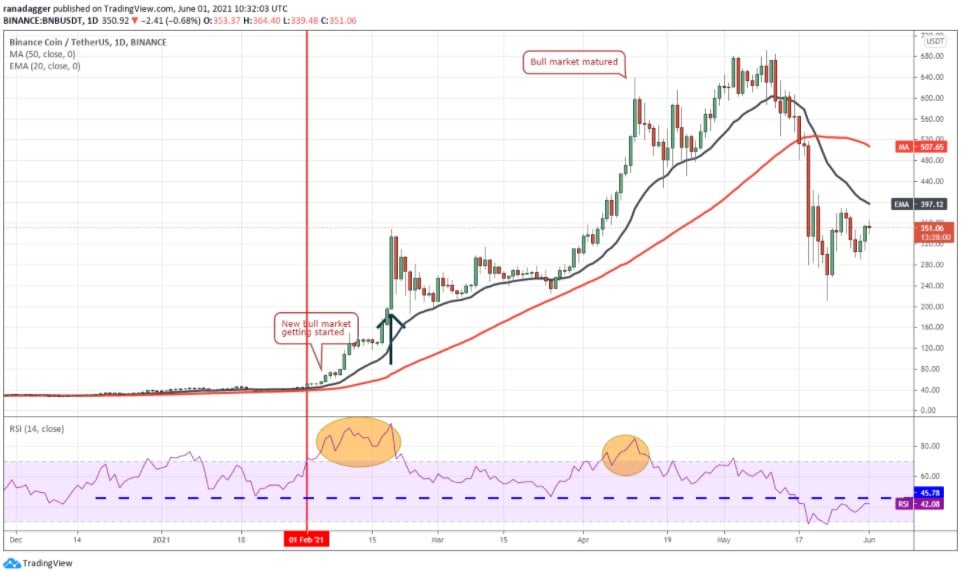 If the RSI gets above 85 during this early period, it is essential to start exercising caution. At the same time as the market reached a new local high of 348 USD on February 19, the relative strength index (RSI) for the BNB/USDT pair climbed over 95. After that, the alternative coin experienced a decrease of 46%, landing at $ 186 on February 23. When the relative strength index (RSI) rises above 85, traders should make adjustments to their stop losses in order to protect their gains. This is because it is difficult to forecast highs during periods of intense buying activity. On April 12th, the relative strength index (RSI) reached a new local high by surging above 85. Even though prices are climbing quickly, traders should use extreme caution when the relative strength index (RSI) approaches 85. It is also important to note that the Relative Strength Index (RSI) does not enter the oversold zone between the months of February and the middle of May. During bullish stages, the RSI typically seems to result in a range that falls between 40 and 50. In the event that the price falls between these levels, investors should exercise caution and search for alternative support signs before opening long positions.
If the RSI gets above 85 during this early period, it is essential to start exercising caution. At the same time as the market reached a new local high of 348 USD on February 19, the relative strength index (RSI) for the BNB/USDT pair climbed over 95. After that, the alternative coin experienced a decrease of 46%, landing at $ 186 on February 23. When the relative strength index (RSI) rises above 85, traders should make adjustments to their stop losses in order to protect their gains. This is because it is difficult to forecast highs during periods of intense buying activity. On April 12th, the relative strength index (RSI) reached a new local high by surging above 85. Even though prices are climbing quickly, traders should use extreme caution when the relative strength index (RSI) approaches 85. It is also important to note that the Relative Strength Index (RSI) does not enter the oversold zone between the months of February and the middle of May. During bullish stages, the RSI typically seems to result in a range that falls between 40 and 50. In the event that the price falls between these levels, investors should exercise caution and search for alternative support signs before opening long positions. 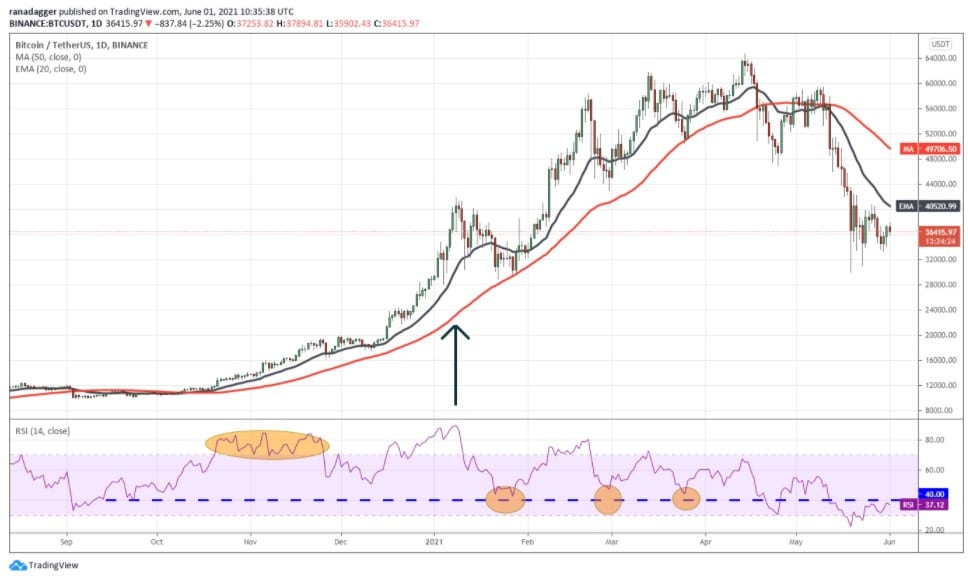 As seen in the preceding illustration, an upward trend for Bitcoin (BTC) began in October of 2020. Take note of how the relative strength index (RSI) shot up to 70 and remained there for the first few days of the bull phase. Despite this, the Relative Strength Index (RSI) had a hard time reaching the severely overbought zone of 85 at this time. When the RSI went over 85 in January of 2021, investors who were selling at the time hit the regional high. As the value corrects, the relative strength index (RSI) falls from the overbought zone to the levels of 40, presenting a chance for traders to buy.
As seen in the preceding illustration, an upward trend for Bitcoin (BTC) began in October of 2020. Take note of how the relative strength index (RSI) shot up to 70 and remained there for the first few days of the bull phase. Despite this, the Relative Strength Index (RSI) had a hard time reaching the severely overbought zone of 85 at this time. When the RSI went over 85 in January of 2021, investors who were selling at the time hit the regional high. As the value corrects, the relative strength index (RSI) falls from the overbought zone to the levels of 40, presenting a chance for traders to buy. 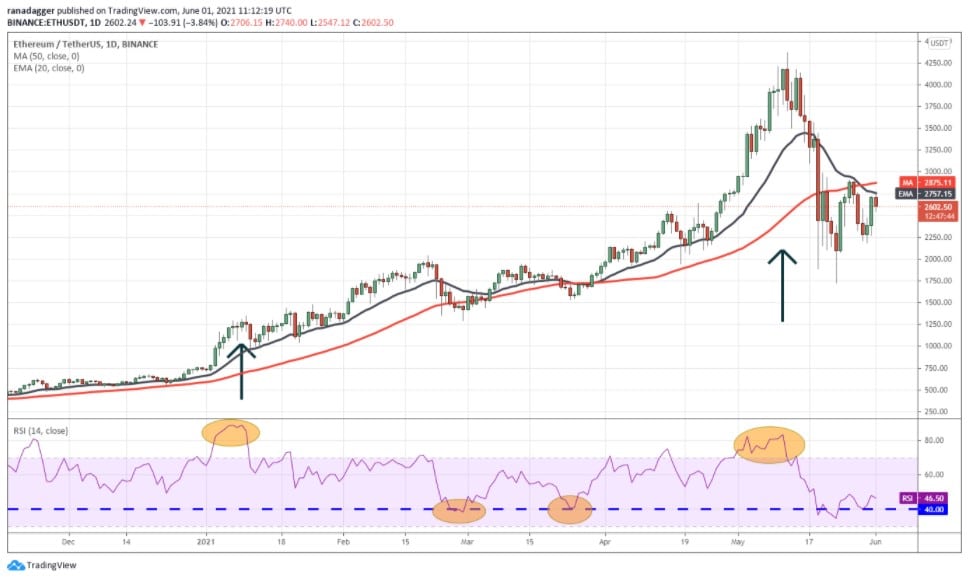 The price of Ether (ETH) started to go up in November 2020, but the Relative Strength Index (RSI) had trouble staying in the overbought range. At the beginning of January, the RSI came dangerously close to reaching 85, which prompted market participants to sell. This exemplifies the fact that no method or signal is guaranteed to be correct in every circumstance. When the relative strength index (RSI) reaches 40, investors have two more opportunities to buy. This presents an opportunity to get into the market and make money off of the remaining portion of the spike. On May 11, the Relative Strength Index (RSI) rose to 83, just below the thresholds of 85, and on May 12, the most popular alternative coin reached its all-time high. a divergence toward the negative Since the RSI is a movement indicator, whenever there is an increase in the value, the RSI also goes up. The Relative Strength Index (RSI), on the other hand, does not always correspond to the price action. Even in situations like this one, where prices are going up, the relative strength index (RSI) is still going down. The phenomenon in question is referred to as negative divergence. This can be a sign that the bullish momentum is losing some of its steam.
The price of Ether (ETH) started to go up in November 2020, but the Relative Strength Index (RSI) had trouble staying in the overbought range. At the beginning of January, the RSI came dangerously close to reaching 85, which prompted market participants to sell. This exemplifies the fact that no method or signal is guaranteed to be correct in every circumstance. When the relative strength index (RSI) reaches 40, investors have two more opportunities to buy. This presents an opportunity to get into the market and make money off of the remaining portion of the spike. On May 11, the Relative Strength Index (RSI) rose to 83, just below the thresholds of 85, and on May 12, the most popular alternative coin reached its all-time high. a divergence toward the negative Since the RSI is a movement indicator, whenever there is an increase in the value, the RSI also goes up. The Relative Strength Index (RSI), on the other hand, does not always correspond to the price action. Even in situations like this one, where prices are going up, the relative strength index (RSI) is still going down. The phenomenon in question is referred to as negative divergence. This can be a sign that the bullish momentum is losing some of its steam. 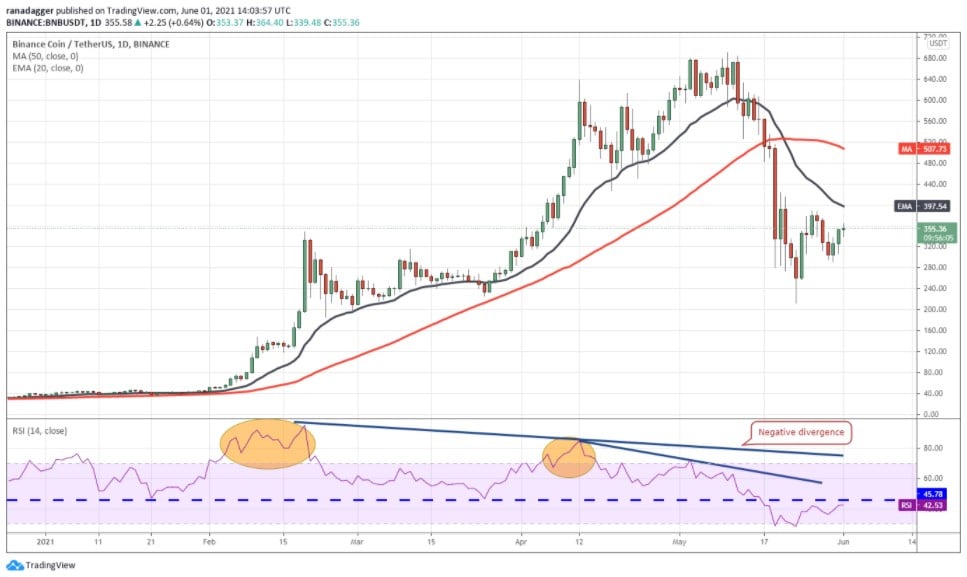 The RSI went above 95 on February 19, the same day that the BNB hit a new all-time high price of $348. After that, the price continued its ascent, but the Relative Strength Index (RSI) struck lower highs, creating a bearish divergence in the market. Traders have taken note of this development, which indicates that the altcoin’s upward momentum is beginning to wane and that a trend shift is likely to occur. It’s possible that investors sold their shares when the RSI fell below 45 or when the price fell below the 20-day exponential moving average (EMA).
The RSI went above 95 on February 19, the same day that the BNB hit a new all-time high price of $348. After that, the price continued its ascent, but the Relative Strength Index (RSI) struck lower highs, creating a bearish divergence in the market. Traders have taken note of this development, which indicates that the altcoin’s upward momentum is beginning to wane and that a trend shift is likely to occur. It’s possible that investors sold their shares when the RSI fell below 45 or when the price fell below the 20-day exponential moving average (EMA). 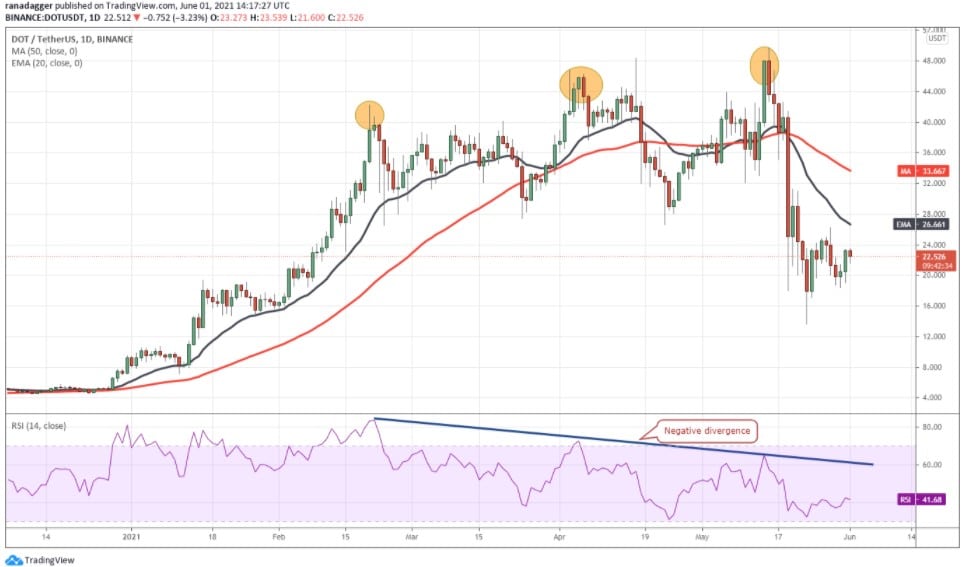 Polkadot (DOT) is yet another excellent example of a significant decrease that was brought on by negative divergence. On the other side, a “sell” indication will not be generated by the RSI in this particular circumstance. As a consequence of this, we shouldn’t put too much stock in relying on an index. Investors may have sold since the RSI suggested that momentum was weakening, and a break under the moving averages signals that the market is shifting.
Polkadot (DOT) is yet another excellent example of a significant decrease that was brought on by negative divergence. On the other side, a “sell” indication will not be generated by the RSI in this particular circumstance. As a consequence of this, we shouldn’t put too much stock in relying on an index. Investors may have sold since the RSI suggested that momentum was weakening, and a break under the moving averages signals that the market is shifting.
What are the advantages of keeping an eye out for deviations?
An indicator such as the relative strength index (RSI) is helpful for determining whether an upward trend has reached its end. Both overbought extreme and negative divergence can be utilized to generate profits before a shift in the trend occurs. Instead of trying to time when the market will top, traders can consider selling their positions if the relative strength index and other technical indicators show that the market is losing traction.
Five Important Roles Of RSI
The relative strength index identifies overbought and oversold levels, but it also possesses a number of other properties that are one of a kind. These are the
The Application of Trendlines
A significant aspect is that the final chart and the relative strength index (RSI) almost go hand in hand. At times, it may be difficult to determine which graph represents the RSI and which represents the closing price. In the final graph, trend lines are produced regardless of whether the data went up or down. Similar to how we would use the closure line graph in RSI, we can also utilize it in this fashion. It is important to keep in mind that RSI trend lines break at least three to four days before they are breached, which suggests that prices will breach the same linear trend within the next day or two. The LIC Housing Finance stock is depicted in the chart that can be found above; as can be seen there, the RSI has already provided an early sell indicator. Both signals occurred on May 9, 2017 and June 14, 2017, as indicated in the figure: The RSI breached an uptrend line on May 9 and then rebounded, but it was met with heavy opposition from an uptrend line on June 14. After receiving the second sell signal, the stock began a downward trend that brought it down about 25 percent from its high.
- Disruption of the Pattern
We are all aware that the formation of trends is a fascinating phenomenon that occurs during chart construction. At some point in the future, every pattern, regardless of whether it is reversing or continuing, will have a breakout. Because RSI analyzes a stock’s underlying relative strength over a predetermined amount of time, this information is quite interesting to learn. A breakthrough of this kind in the RSI will occur at least two to three days before it actually happens, and the price will then follow suit. 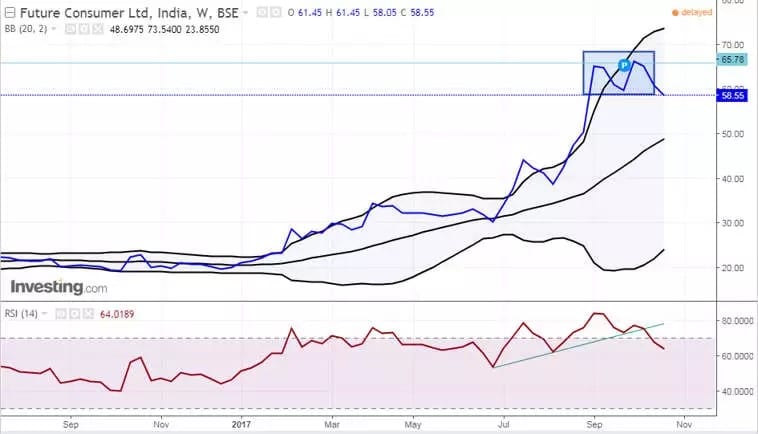 A trend in the RSI for Future customers may be seen in the chart that is located above. Our bullish signal was validated when the market displayed both a dual top formation at the top and a M-top formation in the Bollinger bands at the same time. Shortly after the RSI line broke the neckline, there was a strong price retreat.
A trend in the RSI for Future customers may be seen in the chart that is located above. Our bullish signal was validated when the market displayed both a dual top formation at the top and a M-top formation in the Bollinger bands at the same time. Shortly after the RSI line broke the neckline, there was a strong price retreat.
Breakout and Advance Breakdown of the Situation
The OBV indicator is a great example of how well the concept of advance breakout and breakdown functions. The same concept applies when thinking about repetitive stress injury (RSI). It is referred to as an advance breakout when the indicator (in this case, the RSI) has surpassed the preceding top while the market has not yet surpassed the prior top. In this particular example, the market has not yet surpassed the prior top. As a consequence of this, it can be thought of as a leading or leading indicator, which suggests that the market will continue to follow the signal in subsequent trading sessions. The chart that follows provides an overview of movers in Sanghvi. When we focus our attention on the RSI line, we can see that it has already broken above the previous resistance level, despite the fact that the market continues to maintain its position below it. The stock saw a significant increase not long after the price breakout, which occurred. 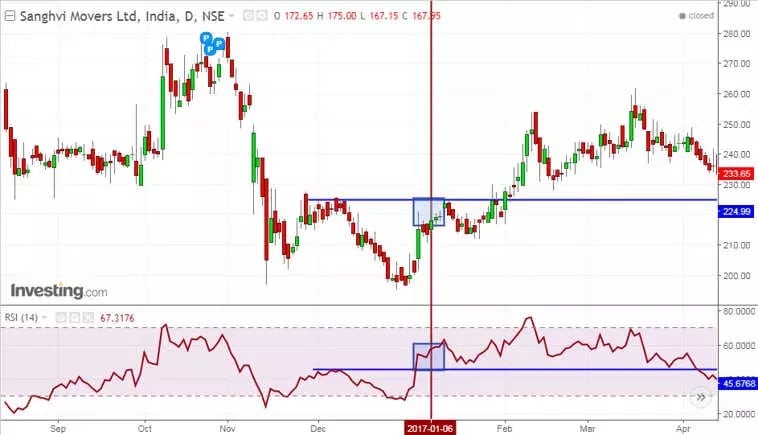 As long as the price remains below or at the prior bottom, the market is exhibiting an advanced breakdown. This indicates that the market is likely to breach the prior bottom in order to see some adjustment in the next days. The RSI has already broken through its prior level of support, as demonstrated by the value chart for Asian paint that can be found below. Soon after that, the value followed suit and, compared to its previous highs, witnessed a significant decline.
As long as the price remains below or at the prior bottom, the market is exhibiting an advanced breakdown. This indicates that the market is likely to breach the prior bottom in order to see some adjustment in the next days. The RSI has already broken through its prior level of support, as demonstrated by the value chart for Asian paint that can be found below. Soon after that, the value followed suit and, compared to its previous highs, witnessed a significant decline. 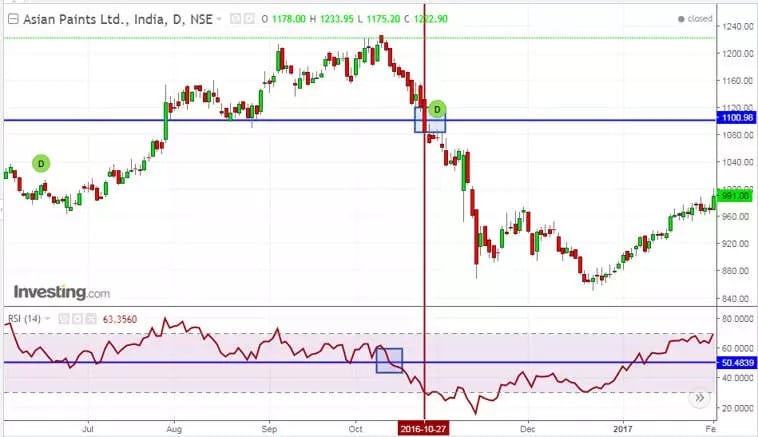
- The Part of 50
The RSI line that is located in the middle of the scale, at 50, is an important line for indicating price changes. While the market is in a bullish phase, the value of the RSI tends to remain above the middle 50 lines. On the other hand, whenever the market is in a bearish phase, the price runs into significant resistance from the RSI 50 line. It is recommended, however, to look at a chart of a broader timeframe, such as a weekly chart, because the daily chart may contain a lot of whipsaws. 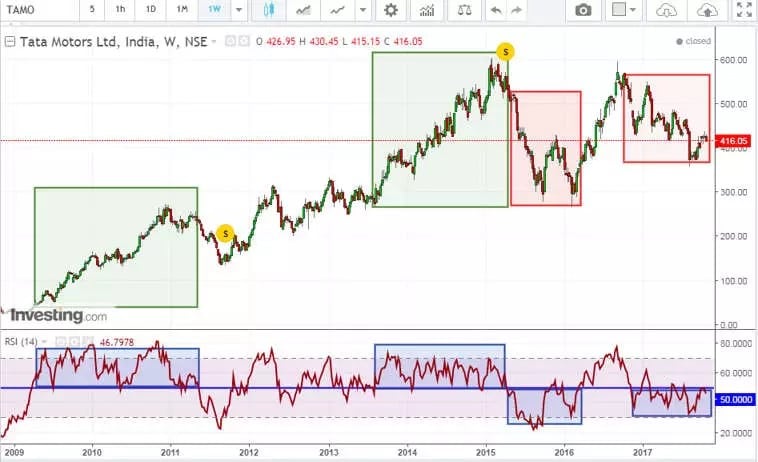 According to the chart that is located above, a bullish market is indicated when the relative strength index (RSI) is above the mid-50 line, but a good correction in the stock price is indicated when the RSI is below the mid-50 line. In a nutshell, we are able to draw the conclusion that the RSI mid-50 line is a fantastic trend changer.
According to the chart that is located above, a bullish market is indicated when the relative strength index (RSI) is above the mid-50 line, but a good correction in the stock price is indicated when the RSI is below the mid-50 line. In a nutshell, we are able to draw the conclusion that the RSI mid-50 line is a fantastic trend changer.
- Failed attempt swing
It is referred to as a bullish failure swing when the Relative Strength Index (RSI) drops below 30 (indicating that the market is oversold), then rises above 30, retreats, stays above 30, and then breaks its prior high. It is, in essence, a recovery to overbought levels, which is then followed by a higher low above those levels. The RSI chart for Asian Paints, which can be shown below, demonstrates a swing that represents a total and utter failure. Shortly after the RSI resistance was overcome, the stock saw a powerful rise that continued for some time. A bearish failure swing occurs when the RSI climbs above 70, then retreats, then rebounds to above 70, and then breaks its previous low. This pattern is characterized by a bearish failure swing. 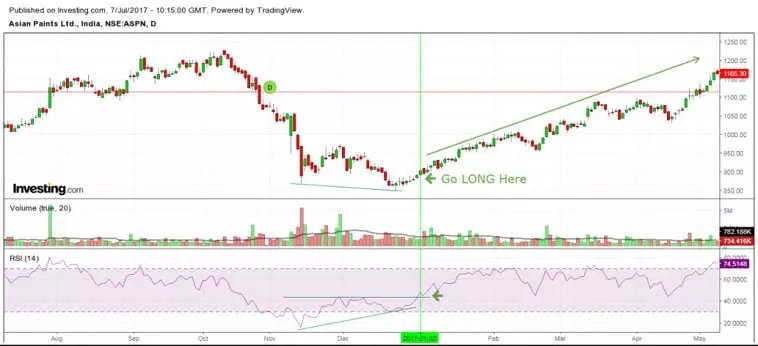 It is, in essence, a climb to levels that are considered to be overbought, followed by a lower high that is below those levels.
It is, in essence, a climb to levels that are considered to be overbought, followed by a lower high that is below those levels.
Price Action Based on the RSI Trade Stop Loss
The fundamental RSI guidelines that were described earlier should be used while placing the stop loss transaction. Once you have located the important juncture in the chart, place your stop loss order so that it is above the most recent swing.
Trading Forex Based on Price Action Using RSI
The USD/CAD H4 chart is what we’re looking at in the figure that’s been provided for us. In the graphic, you can see five different trade ideas that are derived from RSI indicators and price action. Following the initial reduction in price, the first exchange takes place. A positive divergence is produced as a consequence of the relative strength index (RSI) entering the oversold zone. At the same time, a bullish falling wedge is broken due to the movement of the price. Therefore, we have a bullish price movement signal in addition to two bullish RSI indicators. The bottom of the wedge produced during the breakout would be a good place to set a stop loss. Following that, the market will enter a phase of consolidation, which will be represented on the graph by the blue triangle. By penetrating the lower level, the triangle produces a signal that an exit is available.  On the other hand, the breach of the bearish triangle appears to be an indication that is not accurate. The US Dollar to Canadian Dollar exchange rate has changed direction and broken out of the ascending triangle. As a consequence of this, you have the opportunity to take advantage of this occurrence by opening a bullish trade and placing a stop loss below the bottom formed by the blue triangle. When the relative strength index (RSI) indicator reaches the overbought zone, a closing signal is generated. The RSI line has now moved into the territory designated as “overbought.” Following that, it begins to break out, and the line begins to fall. Despite this, the price movement is still heading in an upward direction, which indicates a bearish divergence. During the same time period, an Expanding Triangle appears on the graph. The triangle has a negative potential, and a breach in its bottom level will be regarded as an indicator for entering the market at a shorter time frame.
On the other hand, the breach of the bearish triangle appears to be an indication that is not accurate. The US Dollar to Canadian Dollar exchange rate has changed direction and broken out of the ascending triangle. As a consequence of this, you have the opportunity to take advantage of this occurrence by opening a bullish trade and placing a stop loss below the bottom formed by the blue triangle. When the relative strength index (RSI) indicator reaches the overbought zone, a closing signal is generated. The RSI line has now moved into the territory designated as “overbought.” Following that, it begins to break out, and the line begins to fall. Despite this, the price movement is still heading in an upward direction, which indicates a bearish divergence. During the same time period, an Expanding Triangle appears on the graph. The triangle has a negative potential, and a breach in its bottom level will be regarded as an indicator for entering the market at a shorter time frame.
[rb_related title=”More Read” style=”light” total=”4″]
The stop loss for the trade should be placed above the point at the top of the Expanding Triangle. The trade should be closed when the RSI indicator reaches the oversold zone. As a result of the relative strength index (RSI) reaching the oversold range, we now have a new optimistic indication. However, you will also need a bullish price movement indicator in your toolkit. On the chart, fortunately, there is yet another Expanding Triangle that displays bullish potential. Also, take note of the fact that the end of the triangle hits a support region (in black), which suggests that there may be a bottom beneath the blue triangle. Because of this, there is a greater possibility that the market will start moving in a way that is optimistic. As a consequence of this, you can consider entering a long trade if the price moves below the Expanding Triangle to the upside. It is possible that you will decide to get out of the trade when the RSI enters the overbought zone. the possibility appears on the chart. Also, take note of the fact that the end of the triangle hits a support region (in black), which suggests that there may be a bottom beneath the blue triangle. Because of this, there is a greater possibility that the market will start moving in a way that is optimistic. As a consequence of this, you can consider entering a long trade if the price moves below the Expanding Triangle to the upside. It is possible that you will decide to get out of the trade when the RSI enters the overbought zone. The RSI line continues to oscillate between the overbought zone and the neutral zone. In the meantime, the movement of the price creates a range, which can be seen on the graph shown as the black channel. You might want to consider entering a short trade if and when the market movement breaks down and below the range. After that, place a stop-loss order just above the highest point of the range. Your trade needs to be closed when the Relative Strength Index (RSI) reaches the oversold zone.
The end result
It is recommended that the Relative Strength Index (RSI) be applied in conjunction with a number of other indicators and technical characteristics in order to generate favorable trade signals that are more robustly validated. In addition, users of the StockEdge mobile app who are reluctant to devote a considerable amount of time to analyzing the charts of a variety of different stocks may benefit from the scanning portion of the software. When using the RSI indicator, it is much simpler to keep track of the many trade opportunities that are available. In order to provide more reliable alerts on an end-of-day basis, the application enables you to combine your relative strength index approach with many additional signals, volumes, and market trends. ALSO READ https://twistok.com/read-blog/6696_patrice-evra-a-longtime-man-united-fan-blasts-pep-guardiola-039-s-approach-sayin.html








Leave a Reply